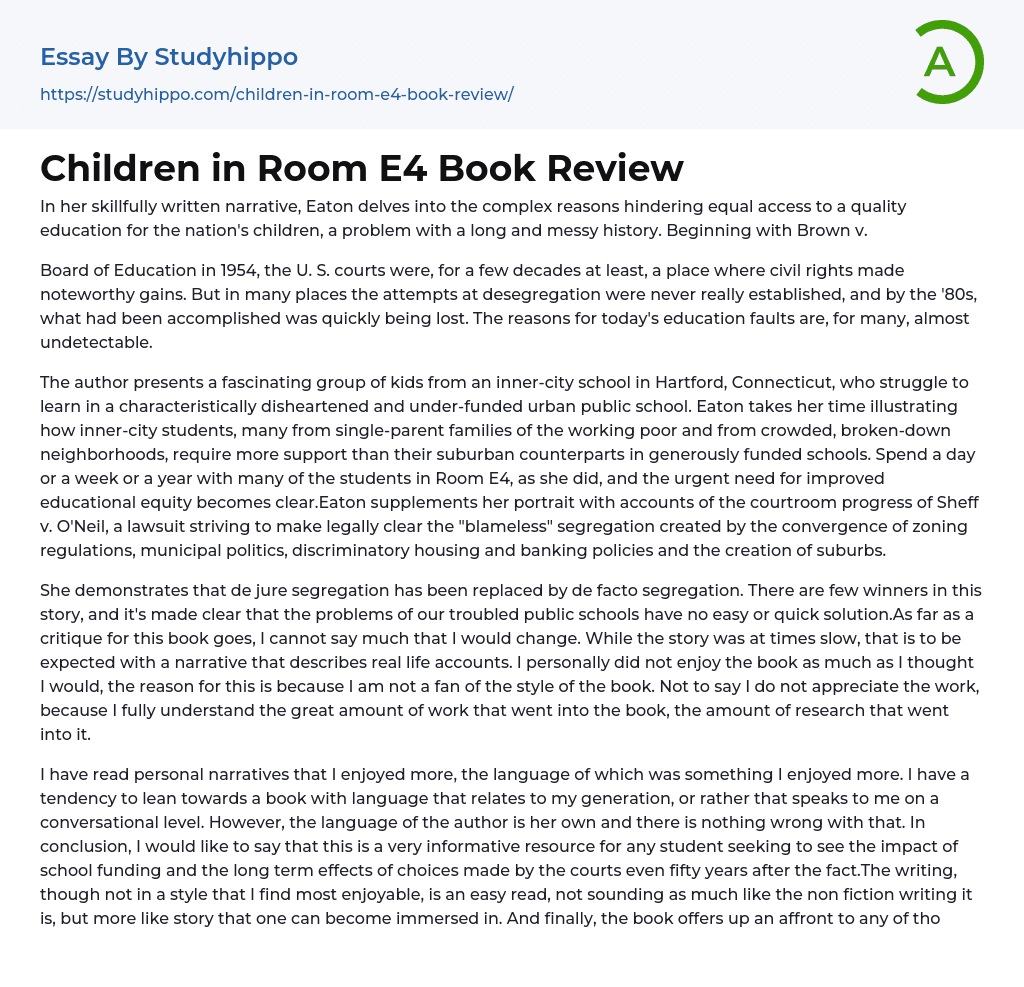The lengthy and complex history of providing equal and exceptional education to all children in the country is examined by Eaton's story. She analyzes various factors that hinder equitable access, beginning with a discussion of Brown v. Board of Education.
Following a significant ruling by the Board of Education in 1954, civil rights were advanced for several decades through crucial involvement from U.S. courts. Despite progress, certain areas still struggled with unsuccessful desegregation efforts, resulting in declining achievements by the 1980s. Nowadays, it can be difficult to identify the root cause of educational inadequacies.
In this captivating narrative, the author depicts a group of children from an urban school in Hartford, Connecticut who face immense difficulties in acquiring an education due to the inadequacies of a poorly funded public school system. Through her portrayal, Eaton reveals how students from inner-city areas
..., predominantly from low-income or single-parent households and living in dilapidated neighborhoods, require more resources and assistance than their suburban peers in better-off schools. By spending time with the students in Room E4 over varying lengths of time, Eaton underscores the dire need for better educational equality. Furthermore, Eaton highlights the progress made in the legal case of Sheff v. O'Neil, which seeks to redress the unintended consequences of segregation caused by zoning regulations, biased housing and banking policies and suburbanization in general.
The author demonstrates that even though de jure segregation is prohibited by law, de facto segregation persists. The predicaments encountered by our struggling public schools have no straightforward resolutions and the outcomes are unfavorable for most parties involved. In general, I have little objection to the book. Although the narrative may occasionally appear sluggish, it
truthfully depicts actual events. Despite not being my preferred writing style, I admire the tremendous amount of effort and investigation dedicated to this book.
Despite my preference for personal narratives that use language more relatable to my generation, I still value the author's unique style. This resource is informative for students interested in the long-term effects of school funding, even after decades have passed. While not my preferred writing style, it presents an easy-to-read story-like format rather than traditional non-fiction. Furthermore, the book effectively challenges those who believe that inner city schools offer equal education despite a lack of funding by presenting a strong argument against this viewpoint.
By being exposed to education in a way that they may not have previously experienced, individuals gain a profound understanding and leave with increased fulfillment.
- Boo Radley essays
- Genesis essays
- Richard iii essays
- Alice in Wonderland essays
- On the road essays
- Ozymandias essays
- The Nightingale essays
- Holden Caulfield essays
- Animal Farm essays
- 1984 essays
- A Hanging essays
- Shooting An Elephant essays
- A Tale Of Two Cities essays
- Adventures Of Huckleberry Finn essays
- Arthur Conan Doyle essays
- Brave New World essays
- Characters In Hamlet essays
- Characters In Romeo And Juliet essays
- Desdemona essays
- Diary Of A Wimpy Kid essays
- First-Person Narrative essays
- Frankenstein essays
- Heart Of Darkness essays
- Jane Eyre essays
- Jay Gatsby essays
- King Duncan essays
- Librarian essays
- Little Red Riding Hood essays
- Lord Of The Flies essays
- Silas Marner essays
- The Cask Of Amontillado essays
- The Catcher In The Rye essays
- The Crucible essays
- The Handmaid's Tale essays
- The Reader essays
- Virgil essays
- Wuthering Heights essays
- Candide essays
- Castle essays
- J. D. Salinger essays
- Ulysses essays
- Ethan Frome essays
- In Cold Blood essays
- Outliers essays
- Tuesdays With Morrie essays
- The Art of War essays
- Wife of Bath essays
- Huckleberry Finn essays
- The Lady With The Dog essays
- Great Expectations essays




